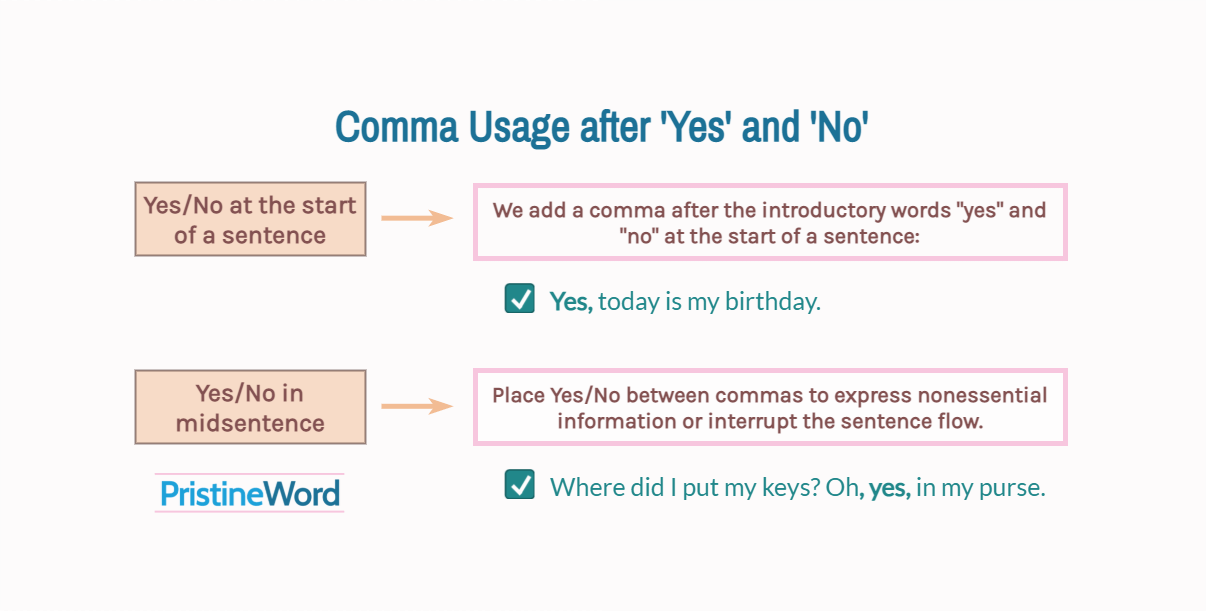We add a comma after the introductory words "yes" and "no" at the start of a sentence.
We add a comma after the introductory words "yes" and "no" at the start of a sentence:
Yes, today is my birthday.
Yes today is my birthday.
In the middle of a sentence, "yes" and "no" should be enclosed by commas to introduce nonessential information or interrupt the sentence flow.
Where did I put my keys? Oh, yes, in my purse.
Where did I put my keys? Oh yes in my purse.
Contents
1. At the Start of a Sentence
When using "yes" or "no" as introductory words, we add a comma at the start of a sentence:
No, I didn't like the movie.
No I didn't like the movie.
We don't need commas, however, if "yes" or "no" is followed by an exclamation or question mark:
No! The money is not yours.
Yes? How can I help you?
Another exception is related to the use of comma with and/or since we do not use a comma before and/or if a list contains two items:
Do you want it? Yes or no?
We also use the expression "yes and no" when we cannot give a specific answer to a question, or the situation is more complex than a simple yes-or-no statement.
Do you like it? Yes and no, I like it to some extent.
You should also use a comma after other introductory phrases and words, such as "by the way", "on the other hand", or "however".
2. 'Yes' or 'No' in Mid-sentence
In general, clauses and phrases that appear in the middle of a sentence must be surrounded by commas.
Make a decision, yes or no, before tomorrow morning.
Make a decision yes or no before tomorrow morning.
Place commas when an expression or clause interrupts the sentence flow.
The difficult answer, yes or no, will be given soon.
The difficult answer yes or no will be given soon.
Do not use commas when "yes" (or "no") is an essential part of the sentence.
I am hoping that she will say yes to my proposal.
I am hoping that she will say, yes, to my proposal.
Do you like her? I would say yes and no.
Incorrect - Do you like her? I would say, yes and no.
3. Categories
As adverbs, "yes" and "no" are used to show agreement or disagreement.
Did you do it? Yes, I did.
Was it your fault that we lost the race? No, it was not my fault.
As interjections, "yes" and "no" are used (typically at the start of a sentence) to express a strong emotion, such as pleasure, excitement, or joy. Interjections are often followed by exclamation marks.
Yes! I won.
No! That's not right.
As nouns, follow the basic punctuation rules when using "yes" or "no".
Was that a yes? Of course! Her answer was a resounding yes.
The reporter spoke to three employees about the reasons they voted no.
When we took the vote on this matter, there were 10 yeses and 3 noes.
"Yes" can also be a verb.
Did he yes the contract?
"No" can be a determiner. We avoid the use of commas in this case.
There is no choice but to act in defense of the Constitution.
There are no hard and fast rules about how to do it right.
4. More Examples
Starting a sentence
- I enjoyed his latest movie. Yes, me too.
- No, you cannot borrow my bike.
- Did you win the lottery? Yes! I've just won $2 million!
- Is this your book? No, it isn't.
- It's an excellent beach. Yes, but it's too crowded.
- I love that car. Yes, I love it too, but it is too expensive.
- Have you ever been to Paris? No, I haven't.
- Can I drive your car? No, you can't.
- Would you like a cup of tea? Yes, thanks.
- Andrew! Yes, sir?
- I've never been to New York. Yes, but you can't remember it. You visited the city when you were a child.
In the middle (or end) of a sentence
- Are you coming or what? Yes, yes, I am coming.
- Why did he say no to me?
- If you are asking me whether Santa Claus is real, yes, he is.
- The answer to your question is no.
5. Conclusion
These guidelines will help you decide how to punctuate the words "yes" and "no" correctly in English:
- Add a comma after "yes" and "no" to give an affirmative or negative response at the start of a sentence.
- Place "yes" or "no" between commas in mid-sentence if they interrupt the sentence flow or are simply included to clarify (as an aside).
- Do not use commas in the middle of a sentence if "yes" or "no" provide essential information; that is, they provide information that cannot be removed without changing the meaning of a sentence.

